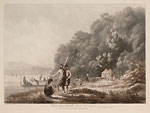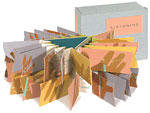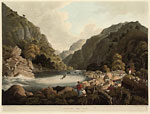South Pacific
Illustrations by Captain Cook’s Artist, Christie’s South Kensington, London, $42,250
An official artist on Captain Cook’s third and final voyage, John Webber produced a substantial body of work to illustrate the official account of 1784, but in the years 1788–92 he made what was then a most unusual move in electing to publish a series of 20 Pacific views after drawings that had not been used in the atlas volume to the official work. The idea that an artist engaged to record the travels or voyages of another might publish his own account was then quite revolutionary.
These original soft-ground etchings are known in various issues and states and were issued uncolored, with sepia and blue-grey washes and, on very rare occasions, colored up, but Webber’s Views in the South Seas from drawings taken on Board the Resolution, 1776 to 1780 are better known from a set of 16 that were re-engraved in aquatint and first published by Boydell in 1808, with the addition of leaves of descriptive text.
Sets issued by Webber during his lifetime (he died in 1793) are now very rare, and this group of 15 views with sepia and bluish-grey washes, the largest I can recall seeing at auction, sold on April 8 at £28,750 ($42,550).
A high was set for the later, and much more familiar, colored Boydell issue in 2007, when the Frank Streeter copy was bid to $50,500 at Christie’s New York.
Head Trip
Contemporary Artist Book, Swanns, New York, $720
There were plenty of more famous names, and books that made more money, but among the contemporary works in this May 5 sale of modern illustrated books was one that must have appealed very much to Mel Ritter’s sense of humor and whimsy. After many decades of collecting, the 82-year-old Ritter decided to put his remarkable collection of artist books up for auction. [See this month’s Digest story on the Ritter collection.]
The headdress itself can be assembled in three forms, each of which, it seems, “invokes the rhythm, tempo and melodic expression of a movement of music.”
Gosh!
Rivers Ran Through It
Himalayan Valley Views, Christie’s South Kensington, London, $44,400
James Baillie Fraser’s Views in the Himala Mountains, a large quarto plate collection published in 1820, was the first set of color plate views of the region. With coloured aquatints printed on thick paper, it was always an expensive item —20 guineas (say, $80) to subscribers and 25 guineas otherwise—and it has remained a rare and costly work to this day. This example showed a couple of pale fox marks to one or two plates, but in its rebacked, rubbed, and scuffed contemporary binding of gilt and blind decorated panelled diced calf, it sold at £30,000 ($44,400).
A Scot, James Baillie Fraser followed in his brothers’ footsteps in going to live and work in India, and in early 1815 he set up as a merchant in Calcutta. It was with his brother William, a political agent, that he undertook his Himalayan journey in 1815, at the time of the Nepal War. The brothers spent two months traveling, chiefly in the river valleys that form the subject of the plate reproduced here, reaching the sources of both the Jumna and Ganges. They occasionally ventured to higher altitudes but were discouraged by the effects of altitude sickness.
The colored aquatints, prepared by Havells from James Baillie Fraser’s sketches, were originally intended to be a companion to his written account, the 1820 Journal of a Tour through part of the Snowy Range of the Himala Mountains. This meticulously documented, detailed, and still very useful account is also rare, though nowhere near as expensive, and by happy chance a copy turned up in a Sotheby’s sale of May 7. Lacking the half title, but complete with map in its 19th-century Russia gilt binding, it sold at £1,875 ($2,775).
Polar Postscript
Robert McClure Letter, PBA Galleries, San Francisco, $14,400
McClure achieved something adventurers had been attempting for centuries, and was lost for three years in the Arctic wastes, so when rescue came, a letter home to the wife was definitely in order. Still, one feels that Robert McClure, writing in April 1853 from H.M.S. Investigator, Bay of Mercy, Polar Sea, verged on the prolix in imparting the good news.
“My Dear Mary, A letter from the Polar Sea is not an event of every day occurrence so I have no doubt it will be highly appreciated, independent of other circumstances which I flatter myself are not altogether unimportant, such as my having been the humble individual to achieve a very interesting service the existence of which was almost considered sceptical, viz the long sought after discovery of a passage between the Atlantic and Pacific oceans, or in other word the ‘N. West Passage,’ which has baffled the endeavors of maritime Europe for nearly four hundred years….”
McClure goes on to give due credit to the Almighty for his safe passage and, in a lengthy postscript, also makes financial arrangements, both in case of his survival or disappearance, and refers to the £20,000 award (then very substantial) being offered for discovery of the passage. In the end, McClure got only half that sum, but his highly significant if wordy letter made $14,400 in this April 30 sale. At today’s exchange rates, the letter sold for pretty much the same amount as McClure received for discovering the Northwest Passage!








 Ian McKay’s weekly column in Antiques Trade Gazette has been running for more than 30 years.
Ian McKay’s weekly column in Antiques Trade Gazette has been running for more than 30 years.

